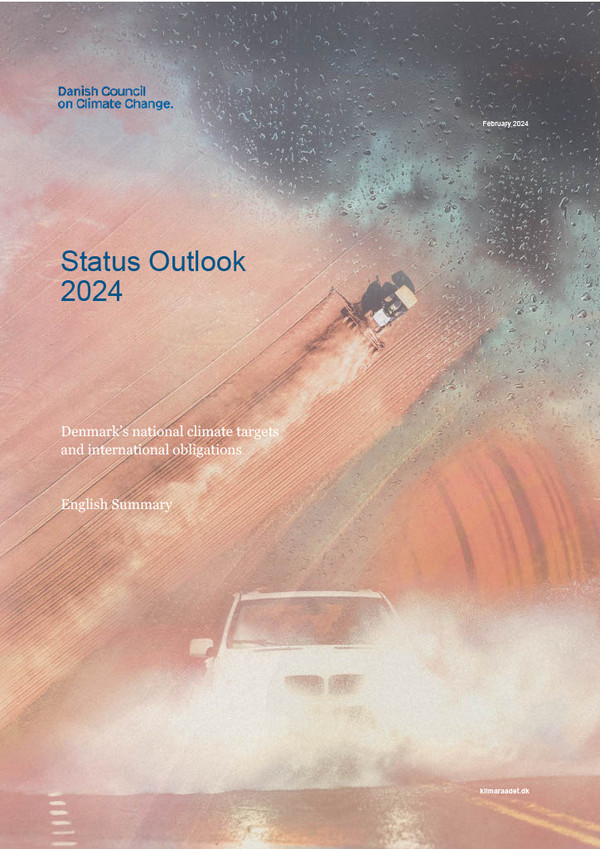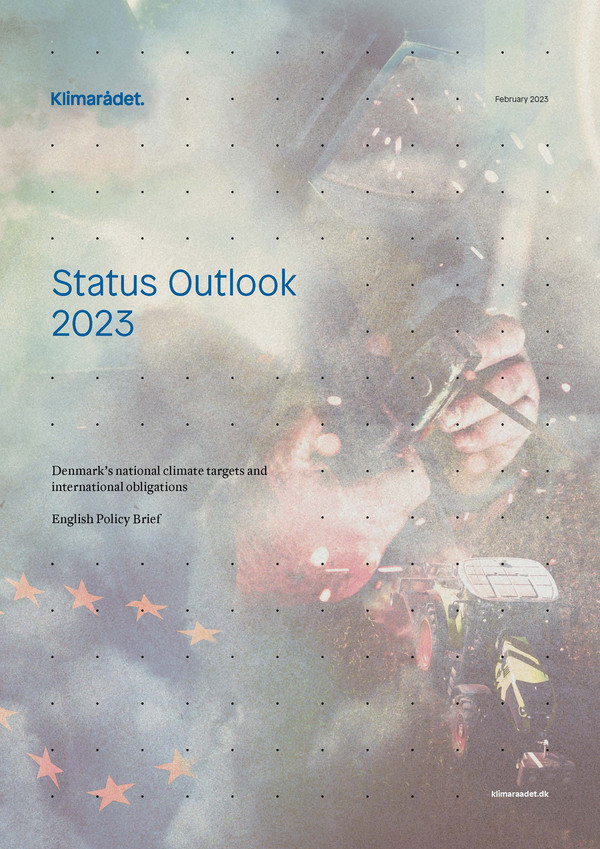
The Role of Biomass in the Green Transition

Preface
Fossil fuels, such as coal, oil and natural gas, must be phased out. It is the only way the world can fulfil the Paris agreement’s pledge and keep global warming below 2°C, as well as enabling Denmark to reach its aim of becoming a low emissions society by 2050. Biomass is one of several renewable energy sources that can be used as an alternative to fossil fuels.
In the main report for 2018, The Danish Council on Climate Change looks at the role of biomass used in the Danish energy system. The report, The Role of Biomass in the Green Transition — Climate Perspectives and Recommendations for Regulation of Solid Biomass Used for Energy Production, focuses on the particular attributes of biomass and how it can be used in the challenge to combat global warming. There are two decisive reasons for doing so:
- Questions are often raised about whether the carbon footprint of biomass is as low as commonly perceived.
- Denmark’s consumption of solid biomass as a source of energy is relatively significant and is expected to continue to increase.
Biomass used for energy comes in many forms. It can be anything from wood, straw and manure, to biodegradable waste and algae, and can come from a variety of sources, such as forestry, agriculture, municipal solid waste as well as waste from gardens. The Council’s report focuses in particular on woody biomass from forests, for two reasons. First, it is to a large extent woody biomass that is burned in Denmark for production of heat and electricity. Second, forests play an important role in the climate system as carbon stores or sinks, that have taken decades or even centuries to develop.
Biomass emits CO2 when burned. As long as the trees are replanted, the CO2 emitted will be reabsorbed, but replanting does not always happen and when it does, many years can pass between the CO2 being released and when it is recaptured again. For that reason Denmark should regulate its use of biomass for energy production in order to avoid any excessively negative climate impact.
Over half of Denmark’s end use of renewable energy comes from solid biomass in the form of wood pellets, wood chips, firewood and straw. As a result, 16 percent of Denmark’s total energy consumption comes from solid biomass, which is the fifth largest proportion among the EU’s 28 member states. But whereas the other countries at the top of the list source their biomass from their own woods and forests, Denmark is unique in importing as much as 43 per cent of the solid biomass used for energy. This significant consumption and the large volume of imported biomass make it essential to develop a regulatory framework that leads to a future in which biomass use in Denmark contributes to the green energy transition in a way that is environmentally friendly and as cost effective as possible.
Recommendations by the Council on Climate Change
Based on this report’s analyses of the conditions governing the use of biomass, the following action is recommended by the Council on Climate Change:
- As proposed by the Council on Climate Change in its analysis, Future Green Taxes on Energy, a reform of energy taxes and subsidies should be undertaken, with no special exemptions made for biomass. Taxes and subsidies in Denmark should be designed with the primary intention of reducing CO2 emissions.
- Biomass should be regulated based on sustainability criteria. Biomass that can be documented as meeting the climate-sustainability criteria should be treated as carbon neutral within the regulatory framework. Biomass that does not meet the criteria should be regarded like a fossil fuel, to be subjected to a CO2 tax that is based on the estimated CO2 content in the biomass and should not be eligible for support on electricity production.
- As part of the tax reform, which among other things should eliminate the favourable tax treatment of biomass, regulation of the district heating sector should be changed to enable all the renewable energy technologies to compete with one another on an equal playing field. This requires:
- Phase out of the requirement for cogeneration of heat and power.
- Phase out of regulations regarding fuel restrictions for district heating.
- A softening of the “non-profit” principle to allow heat producers to attain some of the rewards of investing in heat pumps, similar to the option today when converting from fossil fuels to biomass.
- Adjustment of electricity tariffs in order to reflect the cost structure governing electricity network companies and in this way prevent prices from being a barrier to investments in heat pumps based on electricity.
The proposed regulatory framework is based on sustainability criteria for biomass, in connection with which the Council on Climate Change recommends:
- The Danish government should convene a task force for development of accurate and verifiable indicators that can be integrated into the existing sustainability criteria for solid biomass. The new indicators should focus on the effects on carbon stocks and the carbon cycle that is related to increased use of forest biomass for energy. The indicators should deal with aspects such as the carbon debt repayment time, the country of origin’s climate goals and LULUCF regulation, as well as indirect effects such as indirect land-use changes (ILUC). Relevant stakeholders with expertise in the field of biomass can be included in the work, for example the energy sector, forestry sector, green NGOs and independent researchers with expertise in the earth’s carbon cycle.
- Denmark should implement sustainability criteria for solid biomass in national legislation. These sustainability criteria must include targeted criteria and indicators relevant to the impact on carbon stocks and indirect effects on the carbon cycle. If the forthcoming regulatory framework from the EU does not allow member states to establish additional national sustainability criteria, the Danish government should encourage the energy sector to integrate the targeted criteria and indicators into a voluntary agreement.
- Denmark should work to ensure that the EU’s coming sustainability criteria also include accurately descriptive criteria and indicators that deal with impacts on carbon stocks and indirect effects when biomass is used for energy production.
In a broader international perspective, regulation of forest biomass is vital. In this respect, the Council on Climate Change recommends:
To reach the Paris agreement’s goal of limiting the rise in global temperature, sequestration of carbon is essential, especially in forests. For this reason, when the parties to the agreement renegotiate their climate goals, Denmark should work with the EU and UN for the design of climate targets and regulation that will provide incentives for countries to increase their forest carbon stocks over the business-as-usual reference levels. It is therefore important to set climate targets based on the accounting principles to apply to the LULUCF-sector in order to make sure that the potential volume of LULUCF-credits does not undermine countries’ national climate targets.
The importance of forests to the climate system
The report begins with a description of the global climate system, the role of the world’s forests, and how biomass used for energy can affect the atmosphere. As such it builds an important foundation for understanding how big a role biomass from forests can play in the global effort to meet the climate goals in the Paris agreement.
CO2 sequestration by the world’s forests will, among other initiatives, slow climate change
Soil, trees and other plants provide for a net uptake of CO2 from the atmosphere equal to around one fifth of the world’s total annual emission of CO2. In this way plant growth contributes to alleviate global warming. Without this CO2 sink, the negative impacts of the combustion of fossil fuels on the global climate would be considerably worse.
Plants in general and forests in particular are of major importance to the global CO2-emission budget at our disposal if the global rise in temperature is to be limited to 2°C. The budget set out by the IPCC is based on a continued significant net uptake of CO2 in soil, trees and other plants. A requirement for negative CO2 emissions will arise in the second half of this century, meaning that more CO2 has to be removed from the atmosphere than is released. That can be achieved, for example, by increasing the size of existing forest carbon sinks, by planting new forests or by utilising bioenergy with Carbon Capture and Storage (BECCS), where biomass is burned for energy but the emitted CO2 is captured and pumped underground. BECCS technology, however, is not yet realistically viable and may never prove to be.
Biomass should be regarded as a limited resource
The earth’s available biomass potential is huge. But the carbon storage role played by forests limits how much wood can be extracted in a sustainable way. Recent in-depth studies estimate a sustainable biomass potential of around 100 EJ per year, which is not much more than the current global consumption of 63 EJ a year, taking global population growth into consideration. The 63 EJ represents an average consumption per capita in the world today of around 8 GJ, compared with an estimated sustainable potential of around 10 GJ per capita in 2050.
The limited potential of sustainable biomass stands in contrast to the imperative to replace fossil fuels with renewable energy, including biomass. Thus the use of biomass needs to be carefully considered in the future global energy system.
We should prioritise the use of biomass with a low carbon footprint
Combustion of biomass results in CO2 emissions. In practice, no biomass can be considered carbon neutral in the same way as emission-free energy sources like wind and solar. What separates biomass from the other fossil fuels is that the emitted CO2 from combustion of biomass can be re-captured again over time, provided the trees burned are replanted. Without sufficient replanting, biomass does not deliver climate benefits compared with the use of fossil fuels.
Even when the trees used for biomass are replanted, or the source of the biomass is based on residues from forestry or the timber industry, there is a temporary increase in the atmospheric CO2 content. The longer it takes for felled trees to re-grow, or the longer it takes for waste products to alternatively decay, the larger the resulting carbon footprint. The size of the footprint changes significantly dependent on the type of biomass, making it important, from a climate perspective, to prioritise types of biomass with the smallest possible footprint.
Inclusion of forests in the climate goals
Given the importance of the world’s forests to the climate, both as carbon sinks as well as suppliers of biomass resources, it is vital to include changes in forest management in the international climate change regulations. While that is the intention of the Paris agreement, including changes in emissions resulting from forest management practices in national climate targets has been very challenging to achieve in practice.
The size of carbon stocks held by forests is difficult to estimate
In the big picture, a change in forest carbon stocks will be matched by a change in the atmospheric CO2 content. From a regulatory perspective, the ability to estimate changes in carbon stocks is important. It is extremely difficult, however, to accurately and precisely assess these changes. That is because the annual changes in stocks of carbon are relatively small compared with the size of the stock. A small uncertainty in assessing a change in the carbon stock can thus result in a large uncertainty in assessing the annual change in emissions. In addition it is difficult to separate the changes that occur naturally from those that are caused by human activity. This separation is important as it is human activity that climate regulation is attempting to influence.
Inclusion of forests and LULUCF risks diluting the climate goals of many countries
Under the Paris agreement, national governments must include the so-called LULUCF sector in their climate goals. LULUCF concerns land use and forestry. If a country reduces the stock of carbon represented by its wooded areas, the result must be accounted for as a LULUCF emission. The Paris agreement, however, provides a large degree of freedom of choice in how, exactly, LULUCF can be accounted for, including how changes in forest carbon stocks are measured. Such freedom gives rise to three problems. First, there are strong indications that many countries choose an approach that provides them with as many LULUCF-credits as possible, which can be used to minimise necessary climate action in other parts of the economy. Second, the climate goals of many countries can reveal themselves to be so weak that they can be reached without any additional action, removing the incentive to maintain or increase the size of forest carbon sinks. Third, inclusion of LULUCF blurs greenhouse gas accounting and climate goals, making them so opaque that it weakens control of whether countries are meeting their goals. Against this background, the Council recommends that in international negotiations Denmark should work for tighter rules governing inclusion of LULUCF in national climate goals in a transparent way that does not dilute the climate goals of individual countries.
The EU is currently working to create clearer guidelines on how member states can measure changes in the LULUCF sector in their greenhouse gas inventories. The intention is to prevent the creation of too many LULUCF credits and to encourage member countries to increase the size of forest carbon stocks as a potential climate change mitigation tool. It is too early to assess whether the guidelines will work in practice, given that previous experience with establishing business-as-usual reference levels to measure changes in forest carbon stocks has so far not been positive.
It is uncertain whether bioenergy emissions are cancelled out in the country of origin
CO2 from combustion of biomass is not accounted for in the greenhouse gas emission inventory of a country using the energy. Instead, the emission is included as a LULUCF emission in the country that produces the biomass. As previously noted, however, a large degree of uncertainty is attached to whether the existing rules ensure that the country of origin sufficiently accounts for emissions in its LULUCF inventory and whether the changes registered in the inventory will influence climate action taken by that country. The bottom line is that a consumer of biomass, for example Denmark, cannot automatically presume that emissions of CO2 from a biomass plant can be cancelled out through carbon recapture by forests in the country of origin, or by other parts of that country’s economy.
Sustainability criteria for biomass
Gaps in international regulations governing biomass and the not insignificant difference in the size of carbon footprints left by different types of biomass make it necessary for Denmark to act on its own initiative and take action to control that the biomass we use does not result in climate damage. To achieve that aim, the Council points to sustainability criteria as a practical and applicable tool for the task.
Sustainability criteria for biomass exist today in Denmark and other countries
Denmark already employs sustainability criteria for biomass. A voluntary industry agreement commits energy companies to meeting eight criteria for sustainable biomass, which as well as dealing with the greenhouse gases from the biomass supply chain also take into consideration biodiversity and other issues such as ecosystem impacts. The voluntary agreement was developed in 2014 by two sector organisations, Danish Energy Association and Danish District Heating Association, at the request of the government at the time. Sustainability criteria are also in operation in the UK, the Netherlands and Belgium, but unlike those in Denmark they are enshrined in national regulation rather than being voluntary. The national criteria are similar on a number of points, particularly relating to forest management and requirements to reduce greenhouse gas emissions from the biomass supply chain. Differences are also apparent, however, principally in relation to effects that biomass harvest can have on the carbon cycle and forest carbon stocks.
The EU is currently negotiating common European sustainability criteria for biomass. The plan is for these to come into force in 2021. As yet it is not known if the EU will demand a full harmonisation of biomass sustainability criteria between member states, or whether member states are allowed to have tougher standards for biomass sustainability.
Existing sustainability criteria should focus more on carbon impacts
To a certain extent the Danish energy sector’s voluntary agreement takes the climate effects into consideration, as does the EU Commission’s proposal for European sustainability criteria. But neither the Danish agreement nor the European criteria sufficiently consider the degree to which biomass harvesting can reduce carbon stocks and have indirect effects on the use of wood and use of land. Nor do they contain sufficient operational indicators of the negative effect that increased biomass usage may have on carbon stocks, or require documentation of the carbon footprint of biomass.
There are various ways of taking the climate aspect of sustainability into account. The Climate Council points to the so-called strategic assessment using a risk based approach, which is a sensible and practical model. It identifies the risks to the carbon impacts of using different biomass feedstock from a specified area and biomass is only regarded as sustainable if the risks are small. The strategic assessment model is based on a decision tree approach that requires further development to be more operational and accurate indicators for assessing the affects on the climate of different types of biomass, including, in particular, impacts on the carbon cycle and carbon stocks in forests.
Denmark should lead the way on development of better sustainability criteria
As a user and importer of significant quantities of biomass, Denmark has an interest in development of sustainability criteria that better account for the impact of biomass on the climate. The Danish Council on Climate Change recommends that the Danish government, together with relevant stakeholders, takes the initiative on development of new, targeted climate indicators that can be included in sustainability criteria. The indicators should deal with the effects of biomass on the carbon cycle and forest carbon stocks, including aspects such as replanting, the time horizons for re-absorption of CO2, the country of origin’s climate goals and regulations, and the indirect impact on use of wood (indirect wood-use change) and land (indirect land-use change).
Subsequently, the sustainability criteria for solid biomass that include the new targeted indicators should be implemented in Denmark’s biomass regulation. Should the EU’s coming regulations not allow member states to establish their own, tougher national sustainability criteria, the government should instead encourage the energy sector to include the new indicators in a voluntary agreement. At the same time, Denmark should work within the EU towards inclusion, in the common European sustainability criteria, of sufficient focus on the climate related impact of biomass on the carbon cycle and on forest carbon stocks.
Biomass in the Danish energy system
Sustainability criteria shall lay the foundation for a well considered design of the regulatory framework for use of biomass in Denmark. As a platform for discussion of that framework, this report provides an overview of the role biomass plays in the Danish energy system, both today and in future.
Solid biomass makes up over half of renewable energy in Denmark
In recent years, Denmark has converted a large part of its energy consumption to renewable energy. Wind turbines on land and offshore are often used to portray this conversion, but it is the increased use of biomass that has contributed most to the transition towards renewable energy. In 2016, renewable energy accounted for 31 per cent of final energy use in Denmark, with solid biomass representing 16 per cent of that figure. The remaining 15 per cent came mostly from wind, solar and waste combustion. The consumption of biomass is expected to rise even further in the coming years, with, for example, plans for more conversion of large combined heat and power installations from coal to solid biomass.
Biomass is mainly used for combined heat and power (CHP) production, which delivers heat through district heating networks, or as a fuel for water heaters (boilers) in individual homes. Wood pellets and wood chips are increasingly used for CHP and heat production, while wood pellets and firewood are used in homes. Although the firewood comes from Danish woodland, wood pellets are almost exclusively imported.
With its significant use of imported biomass Denmark is an outlier in the EU
Together with a handful of other countries, Denmark uses a relatively large share of solid biomass as an energy source. Out of the EU’s 28 member countries, Denmark comes fifth, measured in terms of the proportion of biomass in total energy consumption. But while the other countries topping the list contain large forested areas of land, Denmark stands out as an importer of large shares of its biomass consumption. As much as 43 per cent of Danish biomass consumption comes from outside the country. That gives Denmark a special challenge in relation to making sure its use of biomass is climate friendly. Measured per capita, Denmark’s use of bioenergy lies well above the global average. Danish consumption per capita is nearly three times the world potential for a sustainable supply of biomass-based energy globally. The indication is that Denmark could be vulnerable if international demand and prices for biomass rise in future. At the same time, it is difficult for Denmark to function as a pioneering country in the use of biomass.
The regulatory framework is important for the future expansion of biomass
The government’s goal is for renewable energy to make up at least 50 per cent of Denmark’s energy consumption in 2030. As mentioned above, the figure in 2016 was 31 per cent. Biomass can potentially play a major role in reaching this goal, which among other things is seen in the fact that several power stations reliant on coal today must by 2030 find climate-friendly alternatives.
There are other alternatives to biomass. In particular, electricity from wind turbines and solar PV, which is continuously falling in price and with the help of heat pumps can be converted to heat. The Council, based on simulations of the Danish energy system, documents how other renewable energy technologies will advance at the expense of biomass, if market regulations are adjusted towards more equal support levels between different renewable energy sources. Options other than biomass are available for electricity and heat production and these would become attractive in future when the biomass resources are needed for other uses in the transport sector and for materials etc.
Regulatory framework for biomass
The steady expansion of biomass in Denmark has to a large extent been driven by a favourable regulatory framework. Biomass should be part of the future energy system, but it must compete on a level playing field with all other renewable energy sources and to the extent that biomass can be said to be climate friendly. The final chapter in the Council’s report puts forward proposals for how the regulatory framework can best achieve that aim.
Biomass is regulated by taxes, subsidies, requirements and rules
As a general rule, energy consumption in Denmark is taxed. Today that applies to coal, oil products, natural gas and electricity, but not to solid biomass. Biomass for energy production achieves tax-free status, whether it is used in combined heat and power (CHP) stations, by companies or by private households. It is considered to be a renewable energy, no matter its source. This means that biomass based electricity is subsidised, as is the case for electricity from, for example, wind turbines and solar panels. Biomass heat production, on the other hand, is not directly subsidised, but is supported indirectly by not being taxed.
Lastly, biomass falls within the general regulations governing district heating. These include the requirement for co-generation of electricity and heat, which in some cases prevents the production of heat only; fuel specifications that maintain natural gas in some district heating areas; and the net advantage of converting to biomass and avoiding taxes on fossil fuel (the net-advantage model), which provides large CHP installations with additional potential earnings in addition to the benefits of the so-called “non-profit” principle.
The regulatory framework should be based on sustainability criteria
Biomass comes in very different forms. Some types of biomass have a small carbon footprint and other types a large one, dependent on variables such as the type of wood, country of origin, forest management practices, and whether or not the raw material is considered a residual waste product. As described in Chapter 4, sustainability criteria can be used to identify biomass that, with reasonable certainty, has a relatively low carbon footprint.
The Danish Council on Climate Change proposes that the Danish regulatory framework is based on sustainability criteria. Biomass that can be documented as fulfilling these criteria with regard to the climate, referred to here as climate-friendly and sustainable biomass, will continue to be perceived as carbon neutral renewable energy, even though it has to be stressed that biomass is seldom in practice fully carbon neutral. In this way climate-sustainable biomass achieves the same advantages in the regulatory framework as other types of renewable energy. The remaining biomass, on the other hand, should be treated as fossil fuel energy based on an average CO2 content for the purpose of calculating taxes. The estimate for the CO2 content should, in principle, take into account factors such as forest management and climate regulation in the country of origin, but in practice it must be uniformly established for all types of biomass that cannot be documented as climate-sustainable, given that it is not likely to be possible to differentiate between the separate types. A natural step would be the inclusion of “size limits” in the regulation. These would, for example, exempt private people from the requirement to document the sustainability of using wood collected from their own property, but not sold elsewhere.
A reform of the tax system can remove the current preferential treatment of biomass
Biomass has an unjustified, advantageous position in the current tax and subsidy system for energy in Denmark. This preferential treatment is apparent, for example, in the tax saving attainable by replacing coal with biomass in CHP, measured per avoided tonne of CO2, which is larger than the reward attainable as a subsidy or avoided CO2 penalty when replacing coal with renewable energy in electricity production. Another example is seen in the total exemption of biomass from taxes in contrast to the situation of heat pumps today, which pay an electricity tax that exceeds the production subsidy granted on the consumed electricity when it is generated from a renewable source of energy.
The two examples demonstrate the need to reform the energy tax and subsidy system to prevent biomass attaining unjustified advantages. A reformed system should focus on encouraging CO2 reduction through a uniform tax on CO2 emissions and, in cases where a high tax is not expedient, through a subsidy that provides a uniform incentive for CO2 reduction. Such cases occur when a high Danish tax results in the production of emissions being transferred to another country, and where the aim to reduce CO2 emissions is not restricted to emissions originating in Denmark.
The Council’s proposal for an improved tax and subsidy system, which was first presented in an analytical work in April 2018, Future Green Taxes on Energy, gathers the current energy and CO2-tax into a single CO2-levy of a size that expresses the degree of political ambition for CO2 reduction. A discount is awarded on the CO2-levy on Danish electricity production, reflective of the CO2 content of imported electricity, to avoid encouraging imports of electricity from fossil fuel unnecessarily. In return, all electricity consumption in Denmark is taxed at a level equal to the discount on the CO2-levy, with the result that electricity produced in Denmark and imported electricity is taxed completely uniformly in relation to its fossil fuel content. Electricity from renewable energy receives a subsidy equal to the tax on electricity consumption, resulting in a net tax of zero on green electricity.
Only biomass that is not climate-sustainable is subject to a CO2-levy
Climate-sustainable biomass should continue to be exempt from the CO2-levy. Likewise, electricity produced from climate-sustainable biomass should attain an electricity production subsidy in the same way as other renewable energy sources. Conversely, biomass that does not fulfil sustainability criteria in terms of the climate is treated in the same way as fossil fuels, meaning that this type of biomass does not qualify for subsidy and must pay a CO2-levy reflective of the administratively established CO2 content. Taxes can also be used to promote energy efficiency activities by companies and households. Such an energy efficiency tax should in principle apply to all energy sources, including climate-sustainable biomass. Closer examination is required, however, to establish whether taxes are the right instrument for securing energy savings in an efficient manner, or whether other political tools are more effective.
Other regulation should ensure that all renewable energy technologies are treated equally
Fundamentally, energy regulation should strive to achieve a cost-effective green transition. This is done, among other things, by putting all energy technologies on a level playing field in order to avoid, for example, overinvestment in biomass. To do that requires easing some parts of the existing regulatory framework for district heating.
A number of proposals have already been presented for deregulation of district heating. With that in mind, the Council proposes that the requirement for co-generation both power and heat is gradually removed to prevent heat pumps from being unfairly discriminated against in competition with fuel-based technologies such as biomass-CHP. Likewise, existing restrictions on fuel use can be advantageously phased out to create uniform market conditions for all renewable energy technologies. In addition, the principles contained in the net-advantages model should be expanded to also include other renewable energies. Lastly, electricity tariffs should be revised in order to prevent high tariffs becoming a barrier to the utilisation of heat pumps.



